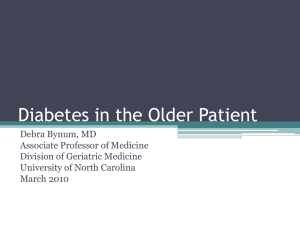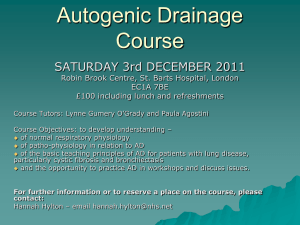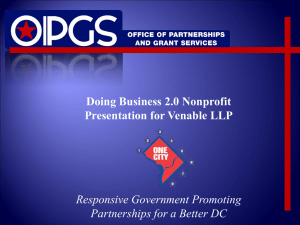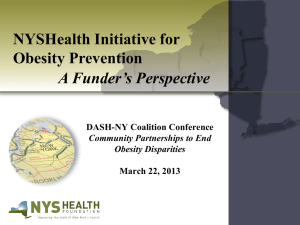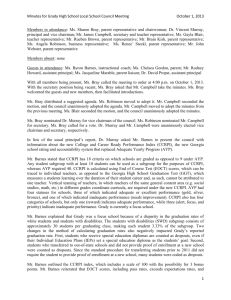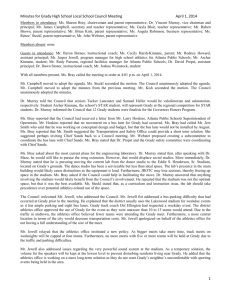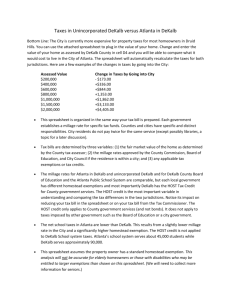Presentation - Atlanta Regional Collaborative for Health Improvement
advertisement
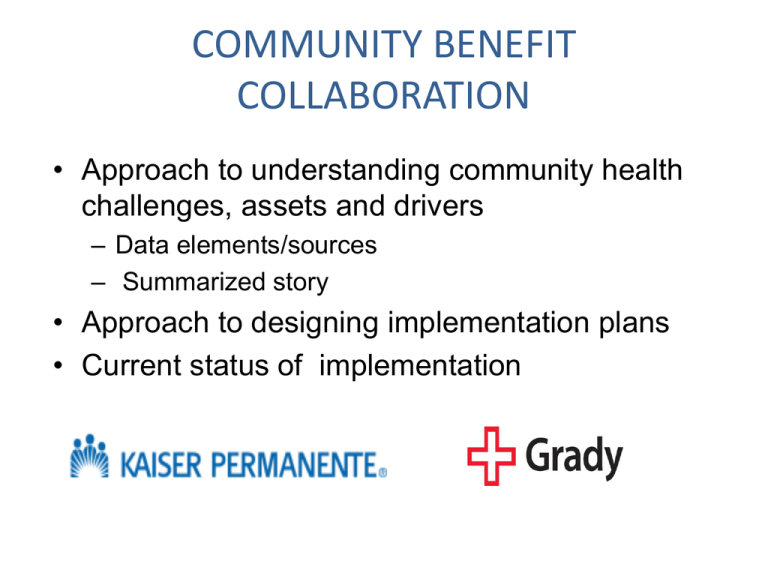
COMMUNITY BENEFIT COLLABORATION • Approach to understanding community health challenges, assets and drivers – Data elements/sources – Summarized story • Approach to designing implementation plans • Current status of implementation BACKGROUND • Kaiser Permanente of Georgia (KPGA) and Grady Health Systems (GHS) partnered with Georgia Health Policy Center to complete CHNA and implementation plan for each system • Considered the specific needs of each community/ service areas; GHS with Fulton and DeKalb service region and KPGA with 30 additional counties (with implications for design of implementation plan) • Alignment with Atlanta Regional Collaborative for Health Improvement (ARCHI) areas of focus was an important consideration in development of implementation plans – 2 Priorities for the Atlanta Region : • Encouraging healthy behaviors • Family pathways to advantage • Coordinated care • Global payment • Capture and reinvest savings • Expand insurance • Innovation fund GHS SERVICE AREA H 1,000+ 400 - 999 200 - 399 50 - 199 0 - 49 Source: Grady Decision Support 3 KPGA SERVICE REGION Kaiser Medical Offices Outline of KP-GA Service Region CRITERIA Criteria Definition Magnitude/ scale of the problem Affects a large number of people within the community Severity of the problem Organizational assets Serious consequences (morbidity, mortality, and/or economic burden) for those affected Has relevant expertise and/or unique assets to address the need Existing or promising approaches Effective, promising evidence- based strategies could be applied to address the need Health disparities Disproportionately impacts the health status of one or more vulnerable population groups. Ability to leverage* Opportunity to work with existing community partners; build on current programs, emerging opportunities, or other community assets. * ARCHI – Healthy Behaviors, Pathways to Advantage, and Care Coordination 5 GHS PRIORITIES Top Priorities Coordinated Care • Diabetes • Prostate Cancer • Hypertension/ Heart Attack and Stroke • AIDS Health Insurance Coverage • Access to Care 6 Middle Priorities Encouraging Healthy Behaviors • Obesity/Diabetes • Hypertension/ Heart Attack and Stroke • HIV/AIDS • Unintentional Injuries Lower Priorities Family Pathways to Advantage • Low Birth Weight • HS Educational NonAttainment Encouraging Healthy Behaviors • STDs GHS IMPLEMENTATION STRATEGIES Focus Area Health Need: 3- Year Goal Strategies Care Coordination Effective and efficient patient care coordination among persons served by Grady Health System Improved coordination of care for patients in Fulton and DeKalb Counties with the following conditions: Diabetes Hypertension/Heart Attack/Stroke Prostate Cancer HIV/AIDS 1. Increased insurance coverage among persons served by the Grady Health System 1. Health Insurance 7 Increased opportunities among persons served by the Grady Health System to access appropriate healthcare services 2. 2. Implement Safety Net Medical Home model focused on the use of patient care/treatment protocols and lay health workers to improve disease management and to control and reduce the likelihood of hospital admissions Collaborate with partners to promote and support Care Transitions Programs Support navigator efforts to increase enrollment of uninsured and disadvantaged populations in the health insurance exchange. Support outreach efforts to enroll eligible individuals in Medicaid and PeachCare GHS IMPLEMENTATION STRATEGIES Focus Area Health Need: 3- Year Goal Strategies Healthy Behaviors Improved sexual health in high risk populations living the DeKalb and Fulton Communities Increased messaging to high risk populations to reduce the prevalence of HIV/AIDS Collaborate and partner with key public health and community based organizations to promote HIV/AIDS prevention Evidence based interventions aimed at reducing obesity in residents of DeKalb and Fulton Increased levels of Physical Activity (PA) in adult residents of DeKalb and Fulton counties Collaborate with key partners including Parks & Recreation, YMCA, Senior Centers, other key partners to promote and facilitate policies and programs that result in increased physical activity: Social support in worksites, senior centers, faith or community sites for walking groups Social marketing & point of decision prompts in target locations including worksites and the broader community Enhancing existing green space & parks improvement Sidewalks & complete streets policies Reduced risk for homicide and injury in target populations in Fulton and DeKalb counties Increased messaging and education to high-risk populations for homicide and injury prevention Collaborate and partner with key education and community based organizations to promote homicide prevention and to reduce unintended injuries 8 KPGA HEALTH NEEDS CHECKLIST Health Needs Drivers Asthma Drug/Alcohol Abuse Cancer Educational non-attainment Diabetes Health Care Inaccessibility Heart Disease/Attacks Physical Inactivity Hypertension Poor Nutrition Low birth weight infants Poverty Mental Health Tobacco Use Obesity Sexually Transmitted Diseases Teen Pregnancy 9 KPGA HEALTH NEEDS (CONSENSUS) Upper Tier Middle Tier Lower Tier Obesity Mental Health Teen Pregnancy Diabetes STD/HIV AIDS Low birth weight Heart Disease Cancer Asthma Hypertension/Stroke KPGA PRIORITIES The primary foci of activity for the next 3 years: Overweight and obesity control Diabetes prevention and management Heart attack and stroke prevention and management Access to care Educational attainment and health literacy 11 KPGA IMPLEMENTATION STRATEGIES Focus Area Health Need: 3- Year Goal Strategies Healthy Behaviors Overweight and obesity control to prevent long term chronic disease in the KPGA service region Increase access to fresh fruits, vegetables and whole grains 1. Provide community-based grants, including technical assistance, to support policy implementation and programs 2. Provide grants to seed urban policy and environmental redesign of communities 3. Convene and collaborate with key stakeholders (e.g. YMCA, United Way, Open Hand, Atlanta Community Food Bank) to facilitate the development of policies and programs that promote behavior change and provide social supports Increase access to physical activity opportunities Increase intake of fruits, vegetables and whole grains by youth in the region Increase moderate-tovigorous physical activity (PA) in children & youth 12 1. Provide grants and technical assistance to schools, non-profits and/or community groups, and other key stakeholders to support, promote and implement healthy school nutrition, physical activity strategies and physical education standards 2. Engage Educational Theater Program and other appropriate internal KP resources to assist in the development and administration of Healthy Eating Active Living productions & programs 3. Convene and collaborate with key stakeholders (e.g. school systems, administrators, and non-profit organizations) to facilitate the development of policies and programs that promote behavior change and provide social supports KPGA IMPLEMENTATION STRATEGIES Focus Area Health Need: 3- Year Goal Strategies Healthy Behaviors Diabetes prevention and management among adults in the KPGA service region Increase percentage of residents achieving glycemic control in the region 1. Provide grants and technical assistance to support community collaborations aimed at increasing knowledge, policies and awareness about the prevention, impact and selfmanagement of diabetes 2. Leverage KP assets (i.e. Medical Financial Assistance, Medicaid, Charity Care, Charitable Health Coverage etc.) and clinical expertise to ensure the availability of, and access to, appropriate diabetes preventive, screening and clinical services 3. Provide grants to organizations that support and promote the expansion of a welltrained health workforce to improve access to care in the community Prevention and management of heart disease, hypertension and stroke among adults in the KPGA service region Increased percentage of residents with normal blood pressure (BP) and cholesterol in the region 1. Provide grants and technical assistance to community partnerships/collaborations to increase health education and awareness of hypertension risk factors, control and cholesterol management 2. Leverage existing KP assets and programs (i.e. Medical Financial Assistance, Medicaid, Charity Care, Charitable Health Coverage etc.) to ensure availability of, and access to quality cardiovascular preventive, screening and clinical services 3. Provide grants to organizations that support and promote the expansion of a welltrained health workforce to improve access to care in the community Care Coordination 13 KPGA IMPLEMENTATION STRATEGIES Focus Area Care Coordination 14 Health Need: 3- Year Goal Strategies Access to health care to ensure better health outcomes the KPGA service region Increase in health care coverage rates for low income populations in the KPGA service region 1. Provide grants to support community based organizations in ensuring low income residents access to quality preventive, screening and clinical services 2. Leverage KP assets and programs (i.e. Medical Financial Assistance, Medicaid, Charity Care, Charitable Health Coverage etc.) to assist individuals in finding health care and enrolling into eligible programs 3. Partner with safety net clinics and community partners to create community solutions to address coverage and access to coordinated care for lowincome residents. 4. Convene and collaborate with key stakeholders (e.g. ARCHI, Philanthropic Collaborative and United Way) to facilitate the development of policies and programs that promote increased access and coverage Increase in access to health care services for low income populations KPGA IMPLEMENTATION STRATEGIES Focus Area Health Need: 3- Year Goal Strategies Pathways to Advantage Improved education and health literacy levels among residents in the KPGA service region Increase in educational attainment for children and youth in elementary and middle school 1. Provide grants to pre-school and other early childhood programs in service region focused on promising and evidence-based interventions that improve students reading through the 3rd grade level (elementary) and support academic reinforcement 2. Engage Educational Theater Program (ETP) in appropriate settings throughout the community to promote improved health education and healthy behaviors 3. Provide grant and technical assistance to support organizations and partners focused on the dissemination of health information, training and guidance for the community 15 Increase in the knowledge and use of health information in the community EXAMPLES OF CURRENT COLLABORATION 16 COMMUNITY CARE MANAGEMENT Project Title: Enhancing Patients’ Lives through Community Care Management Piedmont/Kaiser collaboration provided health care and community resource linkages to low-income, non-Medicare Charity Care-eligible patients with complex, chronic diseases at or below 200% of the Federal Poverty Level to reduce avoidable hospital readmissions and emergency room visits by 20%. Impact and Lessons Learned 17 The project served 352 patients and 324 caregivers (proposed 961 patients and 961 caregivers). Only 3% of program participants were readmitted to the hospital within 60 days. The hospital’s average readmission rate is 11%. Over 11,000 telephone support calls, 270 home visits, almost 1,000 contacts with physician offices and made transportation arrangements, community resource linkages and provided pharmacy assistance. Patients’ health was positively impacted as demonstrated by improved PHQ-9(Patient Health Questionnaire) and PAM (Patient Activation Measure). Clients needed help addressing their social barriers to accessing care. Telephonic model didn’t work well, so Piedmont switched to a social medicine model of care, which focused on the sociological factors that contribute to illness. Patients are able to manage their own care when given the necessary tools. Low-income patients are more quickly labeled “noncompliant” ATLANTA SAFETY NET COLLABORATIVE • • Kaiser Grant for Grady Walk-In Center and Patient Navigator Program – New site on Grady campus for “walk-ins” (Considered FQHC management) – Patient navigators located in the walk-in center, all 4 FQHCs and Grady primary care • 7 navigators – Navigators provided patient education regarding PCMH and scheduled follow up appointments to FQHCs or a Grady clinic – Challenge in getting patients to leave Grady System • History/culture • Co-pays Impact – While program did not drive down ED volumes as anticipated, ambulatory sensitive conditions decreased as a percent of total volume – Program created a platform for further collaboration among safety net ATLANTA SAFETY NET COLLABORATIVE • United Way Community Health Worker Program – Building on Navigator Program, the CHW program targets high-utilizers from the emergency department • 5 CHWs • 2 year program – CHW’s trained for home visits and ongoing support outside of clinical visits – With underlying behavioral health conditions of high-utilizers, program was redirected to focus on patients with high-risk for re-admissions – Continue to have the goal of referring patients without a medical home to the FQHCs and Grady clinics • Impact – One year into the program, initial results indicate reduced re-admission rate for patients assigned a CHW – No determination of impact on patients adopting PCMH MODEL FOR REPLICATION New Program developed – Sams Care Program Primary goal: To increase access to necessary care for uninsured community members in Piedmont’s service communities, avoiding preventable emergency department re-encounters, building upon successes and lessons learned through Piedmont/Kaiser collaboration Primary activities: • Deploy EPIC into three charitable clinics – Fayette CARE Clinic (Fayetteville), Coweta Samaritan Clinic (Newnan) and Hands of Hope (Stockbridge) • Provide for midlevel staffing to expand clinic capacity • Provide for licensed medical social worker to address socioeconomic issues • Create streamlined ED referral process • Measure and capture patient care outcomes, impact on hospital, impact on community • Establish sustainable funding for program • Deploy “phase two” components – disease management, further ED integration 20 OPPORTUNITIES FOR COLLABORATION Q& A 21



